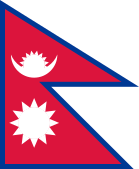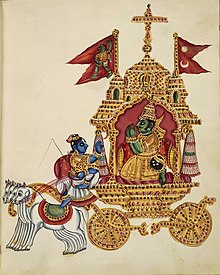Flag of Nepal
 | |
| Triangle Flag | |
| Use | National flag |
|---|---|
| Proportion | see below |
| Adopted | 16 December 1962 |
| Design | Two juxtaposed triangular figures creating an irregular pentagon with a red-coloured base and deep blue borders, there being a white emblem of the crescent moon with eight rays visible out of sixteen in the upper part and a white emblem of a twelve rayed sun in the lower part[1] |
| Designed by | Prithvi Narayan Shah (original) Shankar Nath Rimal (modern) |
The national flag of Nepal[a] is the world's only non-rectangular flag which is used as both the state and civil flag of a sovereign country.[2] The flag is a simplified combination of two single pennants, known as a double-pennon. Its crimson red is the symbol of bravery and it also represents the color of the rhododendron, Nepal's national flower, while the blue border is the color of peace. Until 1962, the flag's emblems, both the sun and the crescent moon, had human faces, but they were removed to modernize the flag.
The current flag was adopted on 16 December 1962, along with the formation of a new constitutional government.[3] Shankar Nath Rimal, a civil engineer, standardised the flag on the request of King Mahendra.[4] It borrows from the original, traditional design,[5] used throughout the 19th and 20th centuries, and is a combination of the two individual pennons used by rival branches of the ruling dynasty.[2]
History
[edit]

 Flag of Nepal (1856–c. 1930)
Flag of Nepal (1856–c. 1930)
 Flag of Nepal (c. 1930—1962)
Flag of Nepal (c. 1930—1962)Historically, triangular shaped flags in South Asia were very common, since it was compact in size so the flag furled even with the lowest wind, thus making it visible over long distances.[citation needed] The traces of triangular flags could be found in Hinduism.[6] The flag's history is vague and there are no specific accounts of its creator. Nepal has historically used both quadrilateral flags as well as non-quadrilateral flags throughout its history.[7]
The flags of almost all states in South Asia were once triangular. A 1928 French book about Nepal shows a double pennant flag with a green border rather than the modern blue.[8] There are other forms of pennant-type flags, mostly used in Hindu and Buddhist temples around Nepal. Many accounts date the creation of the double-pennant to King Prithvi Narayan Shah. The flag of the ancient Gorkha kingdom started off as a single triangular war banner of the Shah kings with a red colour and with various deities and other symbols as symbols in the flag. After Prithvi Narayan Shah unified all small principalities of Nepal, the double-pennon flag became the standard flag. According to some historians, the Rana ruler Jung Bahadur changed the sun and moon symbols into faces of the sun and moon symbolizing the kings as the Rajputs of Lunar dynasty and the Rana themselves as the Rajputs of the Solar dynasty. Nepal has simply maintained its ancient tradition, while every other state has adopted a rectangular or square version in the European vexillological tradition.[9]

The present flag of Nepal was adopted under the Nepalese constitution adopted on 16 December 1962.[10] The modern flag seems to be a combination of the ancient Mustang Kingdom's flag and the ongoing flag used by the former Gorkha Kingdom. The colour gradients have been adopted from the Mustang Kingdom. Prior to 1962, both symbols on the flag, the sun and moon, had human faces. The constitution dedicated an entire section to the precise size and shape of the flag, since people were drawing it incorrectly. This section is continued even today even though multiple constitutions were introduced in the country during the period.[citation needed]
In May 2008 during the drafting of the new constitution, various political parties demanded changes to the flag's design since it symbolized Hinduism and monarchy,[11][12] but this proposal was rejected.[13]

Symbolism
[edit]In modern times, the flag's symbolism has evolved to incorporate several meanings. The crimson red indicates the bravery of Nepali people and is the country's national color and the blue border represents peace and harmony. The colors are often found in Nepalese decoration and works of art.[3] A theory is that the two points represented peace and hard work, using the symbols of the moon and sun respectively. Traditionally the flag of Nepal is derived from Hinduism which is common in Hindu cultures. However, the modern and government-sanctioned representation is of Hinduism and Buddhism, the main religions of the country.[14][15]
The inclusion of the celestial bodies indicates Nepal's permanence and the hope that Nepal will enjoy the same longevity as the Sun and the Moon. The moon also symbolizes the cool weather of the Himalayas, whereas the sun symbolizes the heat and the high temperature of the southern lowlands (Terai).[14] Additionally, the stylized moon represents the calm demeanor and purity of spirit of the Nepali people, while the stylized sun represents their fierce resolve.[9]
Flag layout
[edit]A precise geometrical description of the Nepalese national flag was specified in Article 5, Schedule 1 of the former constitution of the Kingdom of Nepal, adopted on 9 November 1990.[16] Schedule 1 of the Constitution of Nepal, adopted on 20 September 2015, details a specific method of making the national flag of Nepal.[17]

Aspect ratio
[edit]When constructed according to the stated geometric construction law, the ratio of the height of the flag to the longest width is an irrational number. This is common for the hypotenuse of triangles.
This ratio is the least root of the quartic polynomial[19] and arises from the addition of the blue border after construction of the red field. The bounding rectangle of the red field alone has the rational aspect ratio 3:4 (=1:1.333…).[16]
Variations at the Olympics
[edit]
The large-scale production of the Nepal flag is difficult because of its exact proportions and it is normal for it to be completely out of shape during large events. The current Olympic protocol determines that all flags used during the Games have to be manufactured in a 2:3 ratio. On some occasions, such as the flags displayed at some venues of the 2016 Summer Olympics, the flag has been printed on a white cloth.[20] The protocol manual for the 2020 Summer Olympics, by contrast, specifically named Nepal as the only exception to the standard size requirement, instead requiring the Nepali flag to be the same height as the other flags.[21]
Incorrect versions
[edit]During a 2018 visit of the Indian Prime Minister Narendra Modi to Janakpur, a version of the flag with incorrect shape and geometrical proportions was flown by officials, causing outrage on social media and with national personnel.[22]
See also
[edit]Notes
[edit]- ^ Nepali: नेपालको झण्डा, romanized: Nepālko jhaṇḍā, IPA: [nepälko d͡zʱʌ̤n̠d̠ä]
References
[edit]- ^ "Part-1(8) National Flag", Constitution of Nepal, Nepal Law Commission, 2015, archived from the original on 4 June 2020, retrieved 22 May 2020
- ^ a b "Flag of Federal Democratic Republic of Nepal". CRW Flags. Archived from the original on 20 November 2018. Retrieved 31 December 2018.
- ^ a b "Flag of Nepal". Encyclopedia Britannica. Archived from the original on 18 November 2020. Retrieved 24 July 2018.
- ^ रातोपाटी. "यसरी बनेको थियो राष्ट्रिय झण्डाको डिजाइन्, चन्द्र–सूर्य र त्रिकोणको अर्थ के ?". RatoPati (in Nepali). Archived from the original on 31 May 2022. Retrieved 28 February 2022.
- ^ Article I, Section 5 of the Constitution of Nepal (2018)
- ^ "Flags in Hinduism". CRW flags. Archived from the original on 29 May 2022. Retrieved 9 July 2022.
- ^ Nosowitz, Dan (3 September 2018). "Decoding the Unusual Shape of the Nepali Flag". Atlas Obscura. Archived from the original on 18 November 2020. Retrieved 9 July 2022.
- ^ Perceval, Landon (1928). Nepal Vol I. Constable & Co.
- ^ a b "Nepal Flag : Interesting Fact about the Flag of Nepal". Our tech room. Archived from the original on 12 September 2019. Retrieved 8 September 2019.
- ^ "flag of Nepal". Britannica. Archived from the original on 18 November 2020. Retrieved 9 July 2022.
- ^ "Nepal Maoists want to change national flag". One India. 17 September 2009. Archived from the original on 9 July 2022. Retrieved 9 July 2022.
- ^ "Maoists want to change national flag of Nepal". The Times of India. 17 September 2009. Archived from the original on 9 July 2022. Retrieved 9 July 2022.
- ^ "Nepal constitution panel rejects Maoists bid on 'People's War'". The Hindu. 26 December 2009. ISSN 0971-751X. Archived from the original on 9 July 2022. Retrieved 9 July 2022.
- ^ a b "The World Factbook — Central Intelligence Agency". www.cia.gov. Archived from the original on 1 July 2017. Retrieved 24 July 2018.
- ^ "What's with the funny shape of Nepal's flag?". Public Radio International. Archived from the original on 26 October 2021. Retrieved 24 July 2018.
- ^ a b "Nepal – Constitution – Schedules: Schedule 1 (Relating to Article 5)". International Constitutional Law. University of Bern. 9 November 1990. Archived from the original on 1 May 2016. Retrieved 1 June 2012.
- ^ "Schedule-1 National Flag of Nepal". Nepal Law Commission. Archived from the original on 12 October 2022. Retrieved 22 May 2020.
- ^ "Berechnung des Seitenverhältnisses der Nationalfahne von Nepal" [Calculation of the aspect ratio of the national flag of Nepal]. 0xc (in German). 8 June 2012. Archived from the original on 1 August 2016. Retrieved 11 August 2016.
- ^ Sloane, N. J. A. (ed.). "Sequence A230582 (Decimal expansion of the ratio of height to width of the bounding rectangle of the national flag of Nepal, as defined in Schedule 1 of Article 5 of its Constitution.)". The On-Line Encyclopedia of Integer Sequences. OEIS Foundation.
- ^ "Closing Ceremony, 2016, Olympic Ceremonies". Sport. BBC. Archived from the original on 22 July 2022. Retrieved 21 December 2017.
- ^ FLAGS AND ANTHEMS MANUAL : TOKYO 2020
- ^ "Ministry seeks explanation on disfigured national flag". Kathmandu post. Ekantipur. Archived from the original on 22 November 2018. Retrieved 24 July 2018.
External links
[edit]- Flag of Nepal
- Nepal at Flags of the World
- Archived at Ghostarchive and the Wayback Machine: Grime, James (3 August 2012). "The Most Mathematical Flag". Numberphile. Brady Haran.
- Explore Nepal – Download Nepal Flag
- Amazing Facts about Flag of Nepal
- Nepal Flag – History, Meaning, Facts and More


